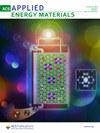电解质成分对层状结构电池双相结构电解质的影响
IF 5.4
3区 材料科学
Q2 CHEMISTRY, PHYSICAL
引用次数: 0
摘要
双连续固液电解质可将高离子传导性与高机械性能结合起来,为实现层状结构电池提供了机会。聚合诱导相分离是制造这些电解质的一种简便的一锅反应。这种方法用途广泛,但由于高度依赖于系统,因此需要控制各种参数的复杂相互作用,以调整双相电解质的形态和性能。本研究探讨了硫醇-烯化学以及液体电解质中的致孔剂类型和含量、硫醇含量和盐浓度等参数的影响,并将这些因素与其固化行为、形态和多功能特性联系起来。我们提供了一个工具箱,展示如何通过改变这些参数来实现不同的形态和性能。致孔剂类型和致孔剂含量每增加 10%,对离子传导性的影响就会增加一个数量级。硫醇-烯化学加速了固化过程,但降低了机械性能,而少量硫醇则略微提高了离子导电率。与之前的研究相比,含有碳纤维作为负极的最佳负极结构电极显示出更高的速率能力,在电流密度为 18 mA g-1 时,放电容量为 219 mA h g-1(∼0.08C)。研究结果还表明,在结构电极中应用高浓度电解质的概念可以提高安全性和容量保持率,同时保持高比容量和良好的速率能力。有趣的是,电解质离子电导率的提高并不总是意味着结构电极电化学性能的改善。本文章由计算机程序翻译,如有差异,请以英文原文为准。

Effect of Electrolyte Composition on Biphasic Structural Electrolytes for Laminated Structural Batteries
Bicontinuous solid–liquid electrolytes can combine high ionic conduction with high mechanical performance and provide an opportunity to realize laminated structural batteries. Polymerization-induced phase separation is a facile one pot reaction to make these electrolytes. It is a versatile method but requires control over the complex interaction of various parameters to tune the morphologies and properties of biphasic electrolytes as it is highly system dependent. This study examines the effects of thiol–ene chemistry and parameters such as porogen type and content, thiol content, and salt concentration in the liquid electrolyte, linking these factors to their curing behavior, morphology, and multifunctional properties. We present a toolbox showing how different morphologies and properties can be reached by changing these parameters. The porogen type and a 10% increase in the porogen content affected ionic conductivity by an order of magnitude. Thiol–ene chemistry accelerates the curing process but reduces mechanical properties while slightly increasing the ionic conductivities for small amounts of thiol. The best negative structural electrode, containing carbon fibers as negative electrode, showed increased rate capability compared to previous work and a discharge capacity of 219 mA h g–1 at a current density of 18 mA g–1 (∼0.08C). The results also indicate the potential of applying the concept of highly concentrated electrolytes in structural electrodes to improve safety and capacity retention while maintaining high specific capacities and good rate capability. Interestingly, the increased ionic conductivity of the electrolyte does not always imply an improved electrochemical performance of the structural electrode.
求助全文
通过发布文献求助,成功后即可免费获取论文全文。
去求助
来源期刊

ACS Applied Energy Materials
Materials Science-Materials Chemistry
CiteScore
10.30
自引率
6.20%
发文量
1368
期刊介绍:
ACS Applied Energy Materials is an interdisciplinary journal publishing original research covering all aspects of materials, engineering, chemistry, physics and biology relevant to energy conversion and storage. The journal is devoted to reports of new and original experimental and theoretical research of an applied nature that integrate knowledge in the areas of materials, engineering, physics, bioscience, and chemistry into important energy applications.
 求助内容:
求助内容: 应助结果提醒方式:
应助结果提醒方式:


